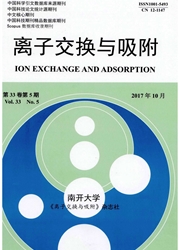

 中文摘要:
中文摘要:
针对MER型沸石骨架和骨架外阳离子进行分子模拟研究。采用密度泛函理论(DFT)计算MER型沸石骨架中Al替代Si的替代能,确定了沸石骨架中Al替代Si的位置顺序,其优先位置为T_2;确定了骨架最小Si/Al为1.67。在此基础上,应用巨正则蒙特卡洛(GCMC)方法模拟MER型沸石骨架外阳离子的位置,并用DFT计算其结合能。结果表明,骨架外K~+、Na~+及NH_4~+有3种吸附位置,K~+优先占据弯曲的八元环;吸附位置中,K~+与NH_4~+优先吸附在Ⅱ位,其次是Ⅰ位,最后是Ⅲ位;在低Si/Al时,Na~+优先吸附在Ⅱ位和Ⅰ位,随Si/Al增加,Na~+优先吸附在Ⅲ位;从结合能的角度,沸石对K~+的吸附能力最强,其次是Na~+,最后是NH_4~+;Ⅲ位阳离子最容易交换,其次是Ⅰ位,最难交换的是Ⅱ位;阳离子与骨架的结合能越大,MER型沸石骨架外阳离子与骨架原子O和Al的平均距离越小。
 英文摘要:
英文摘要:
MER type zeolite framework and extra-framework cations were investigated by molecular simulation method. Substitution energy of Si substituted by Al in MER type zeolite framework was calculated by Density Functional Theory (DFT). It can be found that a preferential siting of Al was in zeolite framework site T2 and the minimum Si/Al of zeolite framework was 1.67. Based on these facts, extra-framework cation sites in MER type zeolite were simulated by Grand Canonical Monte Carlo (GCMC) method and binding energy between cations and atoms of zeolite framework were calculated by DFT. The results indicated that there were three kinds of sites located by extra-framework K^+, Na^+ and NH4^+, and K^+ sites were priority in buckled tings. The most favorable sites of K^+ and NH4^+ in the sorption sites were site II, followed by site I and III. When the Si/Al was lower, Na^+ sites were priority in site II and I, however, the most favorable sites of Na^+ were site III with the increase of Si/Al. From the point of binding energy, the preferable cation adsorbed by zeolite was K^+, followed by Na^+ and NH4^+, in addition, the cations located in the site III firstly exchanged with other cations, followed by site I and II. The higher the binding energy, the shorter the average distance between extra-framework cations and O as well as Al in zeolite framework.
 同期刊论文项目
同期刊论文项目
 同项目期刊论文
同项目期刊论文
 期刊信息
期刊信息
